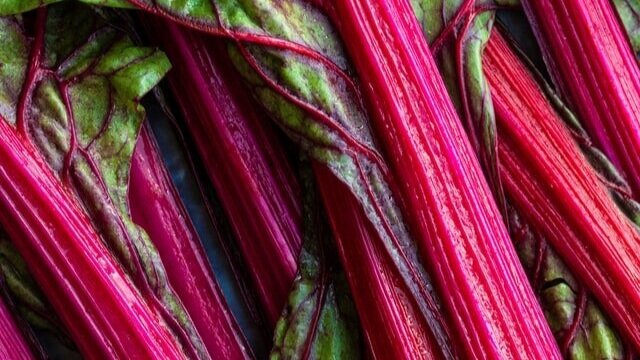Rhubarb
Rhubarb is a hardy vegetable that prefers cool temperatures. You can only eat the stalk of rhubarb. The leaves are actually poisonous.
VarietiEs
The variety of rhubarb you plant depends on how you want to use it. Some varieties, like Canada Red, are best for pies while Sunrise, a pink stalked variety, is best for canning and freezing. Rhubarb comes in a variety of colors, from deep red to pink to striped. Common red-stalked rhubarb includes Valentine, Canada Red, Holstein Bloodred, Colorado Red, and Victoria, one of the sweeter varieties. German Wine is pink-speckled and green and Sutton Rhubarb is red and green-streaked.
WHERE RHUBARB THRIVES
Regional compatibility
Rhubarb does best in cool regions, where temperatures rarely go above the mid-70s in summer. It needs cold weather to grow, so it can rest every year in winter and be jolted into growth every spring. In warm climates it's often grown as an annual.
Optimal shade & sun
Full sun is best for rhubarb growth in moderate to cool regions. Light partial shade is better for growth and flavor if you live in a warm climate.
RESILIENCE
Adaptability to climate extremes. Rhubarb handles cold and wet extremes very well. It actually benefits from occasional cold snaps that drop below 40 degrees. It can also withstand brief periods of drought. What rhubarb doesn't like is a lot of rain, which can result in stunted growth and thin, weak stalks. Mixing some gravel into soil or planting it in an elevated location so it drains well can help keep the roots dry.
Drought resistance. Rhubarb can withstand brief periods of drought. In fact, it is easy to give rhubarb too much water resulting in stunted growth and thin, weakened stalks.
PREP YOUR SOIL
Optimal type of soil. Rhubarb likes fertile soil, that's heavy in organic matter. It also does best in a well-drained site.
PLANTING
When planting indoors. Rhubarb is typically grown from crowns, which look like root stubs. Planting rhubarb from seed takes a much longer time to harvest. But if you want to start with seed, start indoors eight to 10 weeks before the end of spring, or the last frost. Rhubarb likes cool weather and transplants can be set outside as early as two weeks before the last frost as long as they're at least four inches tall.
When planting in the garden. Start by digging a hole about one foot by one foot. Mix in some compost - rhubarb is a heavy feeder so it loves the added nutrients a helping of compost provides. Once the hole is dug, plant your crowns with the roots two-to-four inches beneath the soil line. Plant rhubarb at least four feet apart because these plants take up a lot of space.
Growing
Once rhubarb is established it grows quickly and requires little tending. Add a layer of well-rotted, high-nitrogen compost mulch in the spring and the fall to stave off weeds and help keep moisture in the soil. Compost works well because it adds nutrients and nitrogen to the soil for the next growing season.
WaterinG
Water young rhubarb frequently. Rhubarb needs a lot of moisture to survive, particularly in the summertime. Mature rhubarb needs much less water but its large leaves can bake in the sun. In most regions of the country, you can get away with one good soak per week, wetting the soil at least four inches deep.
Mulching
Add a layer of well-rotted, high-nitrogen compost mulch in the spring and the fall to stave off weeds and help keep moisture in the soil. Compost works well because it adds nutrients and nitrogen to the soil for the next growing season.
CHALLENGES
Pests. Sometimes rhubarb leaves can be damaged by aphids, thrips, and beetles but this isn't a big deal because it won't affect rhubarb flavor. Keep your rhubarb weed-free and pests won't be an issue to begin with.
Diseases. Rhubarb is susceptible to crown rot. To prevent it, plant your rhubarb in a well-drained place. Once plants are infected, it's impossible to get rid of the disease so just dig up your compromised crowns and get rid fo them. Do not replant rhubarb in the same place.












